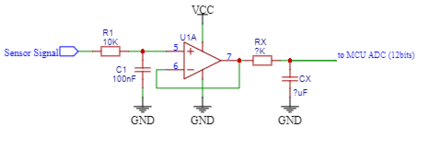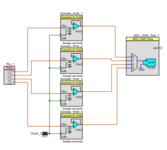michcfr
Advanced Member level 4
Hello,
I need to connect an analog sensor to a MCU SAR ADC input. The tricky point is I want to design a generic circuit that can adapt to:
-various types of analog sensor, not known in advance
-various type of MCU (not known in advance) with 12bits resolution SAR SAR ADC
To cover the more general solution, I think to use a buffer opamp like in the attached schematic. So my questions are:
1)Is it a viable schematic regarding my requirements?
2)if yes:
-R1C1: necessary? correct values?
-RXCX: necessary? typical values?
-suggestion for the op-amp(U1A)?
Fell free to ask questions if it is not clear to you. Thx
Regards,
Michel
I need to connect an analog sensor to a MCU SAR ADC input. The tricky point is I want to design a generic circuit that can adapt to:
-various types of analog sensor, not known in advance
-various type of MCU (not known in advance) with 12bits resolution SAR SAR ADC
To cover the more general solution, I think to use a buffer opamp like in the attached schematic. So my questions are:
1)Is it a viable schematic regarding my requirements?
2)if yes:
-R1C1: necessary? correct values?
-RXCX: necessary? typical values?
-suggestion for the op-amp(U1A)?
Fell free to ask questions if it is not clear to you. Thx
Regards,
Michel

